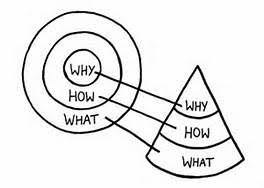Simon Sinek wrote the book “Start With Why” to satisfy his own why, which is to help people feel fulfilled and valued in their roles at work. He uses examples of successes and failures to elucidate the importance of having a “Why” in life and in business. If you are familiar with his TedTalk, this book expands upon the ideas he mentions, and makes compelling arguments for these examples by going into deep detail.
Notable Points:- The Golden Circle – Visualized as a bullseye, the Golden Circle is made up of concentric circles that represent different layers of thought and behavior. The center is “Why”, surrounded by a circle of “How” and a more distant outer circle of “What”. Sinek emphasizes the importance of why by relating it to our brain’s evolutionary biology. Our “limbic” brain, which is responsible for performing baseline processes, is the most primitive and visceral structure in our brain, and arguably our source of “Why”. The reason we often cannot articulate deep emotional feelings is because they are being processed by this region of the brain, which is incapable of speech.

- The Golden Circle in 3D – Sinek says that when you flip the Golden Circle on its side it looks like a cone, with “Why” forming the point. This is a useful visual because it emphasizes how the “Why” serves as the message that disperses from its origin, as well as demonstrate how there is potential for error at scale if the “Why” is not clear to start.

- “People don’t buy what you do, they buy why you do it.” – Sinek uses this expression to stress the importance of finding a company’s “Why” to optimize its potential. Customers are buying the “What”, or the tangible product, but believes that the “What” itself is best meant to serve as proof for the company’s “Why”. For example, Southwest Airlines believes that people should be empowered to live their own life. Their “What”, a low cost airline, enables customers to affordably travel for reasons that are important to them. This is best summarized in their first slogan, “You are now free to move about the country.” The “What” is proof of the “Why”.
- The Law of Diffusion of Innovation – Sinek argues that the tipping point for adoption of a new idea or products occurs when the asset reaches 15-18% market penetration. In order to reach that value, products must grab the attention of early adopters, who are notoriously influenced by their personal alignment with a company’s “Why”. He claims that this is why people will wait in line for hours to be the first to get a new Apple iPhone – because they pride themselves on being that type of person. They identify with it, and Apple’s brand. Companies that fail to gain the support of early adopters must rely on converting the early majority, which comes at a very expensive price tag because as a group they are very difficult to penetrate.

- Whys Need Hows – History’s most visionary of founders relied on other individuals that were better at executing their ideas. Sinek talks about the “Why” being the destination and the “How” being the route. He explains how Walt Disney required his brother Roy to implement his vision, and how Steve Jobs needed Steve Wozniak to found Apple. The vision needs direction. An example he uses often, Dr. Martin Luther King Jr., could only do so much for the civil rights movement. His “Why” inspired the real actionable component of the movement, which was his following and the strength they had as an organized unit to enact change. Sinek aptly puts it, one provides the vision statement, the other the mission statement. He even goes on to argue that more entrepreneurs are “How” types than “Why”.
- The Split – Sinek talks about how companies often fail to maintain their “Why” when they lose their original visionary, and thus become less effective and profitable. He talks about how Sam Walton embodied his target demographic by taking a reasonable salary and not exploiting wealthy privileges, and after he passed away, Walmart lost its momentum because the next leaders did not embrace those same characteristics.
Sinek does a great job of telling stories about relatable and recognizable companies, and the factors that effected their progression. Beyond providing inspiration to find your own “Why”, this book reveals how easily influenced we all are by public image, as well as suggest new ways to think about the decisions we are making around us. It is a great way to get a better understanding of our own subconscious and learn how to motivate people in an effective way.
By using examples from Martin Luther King Jr, to the Wright Brothers, to Southwest Airlines, “Start With Why” is an important addition to your bookshelf and is filled with essential insight!
Advertisements Share this:





